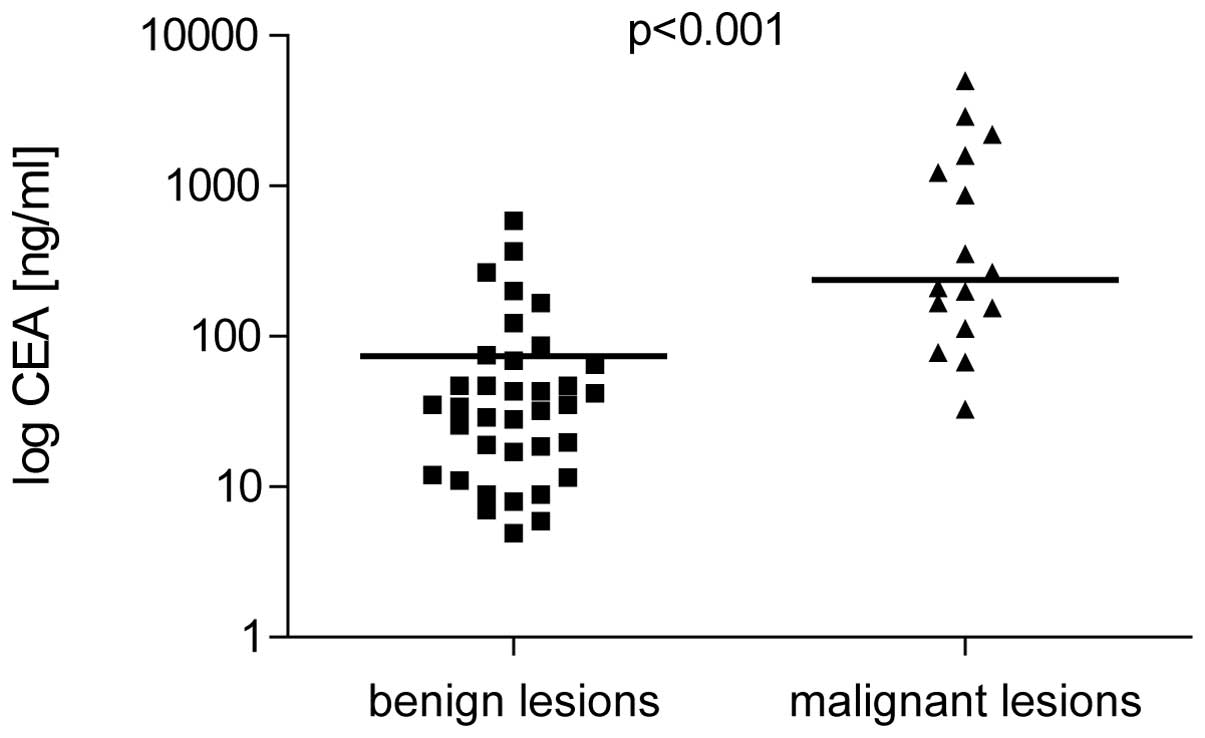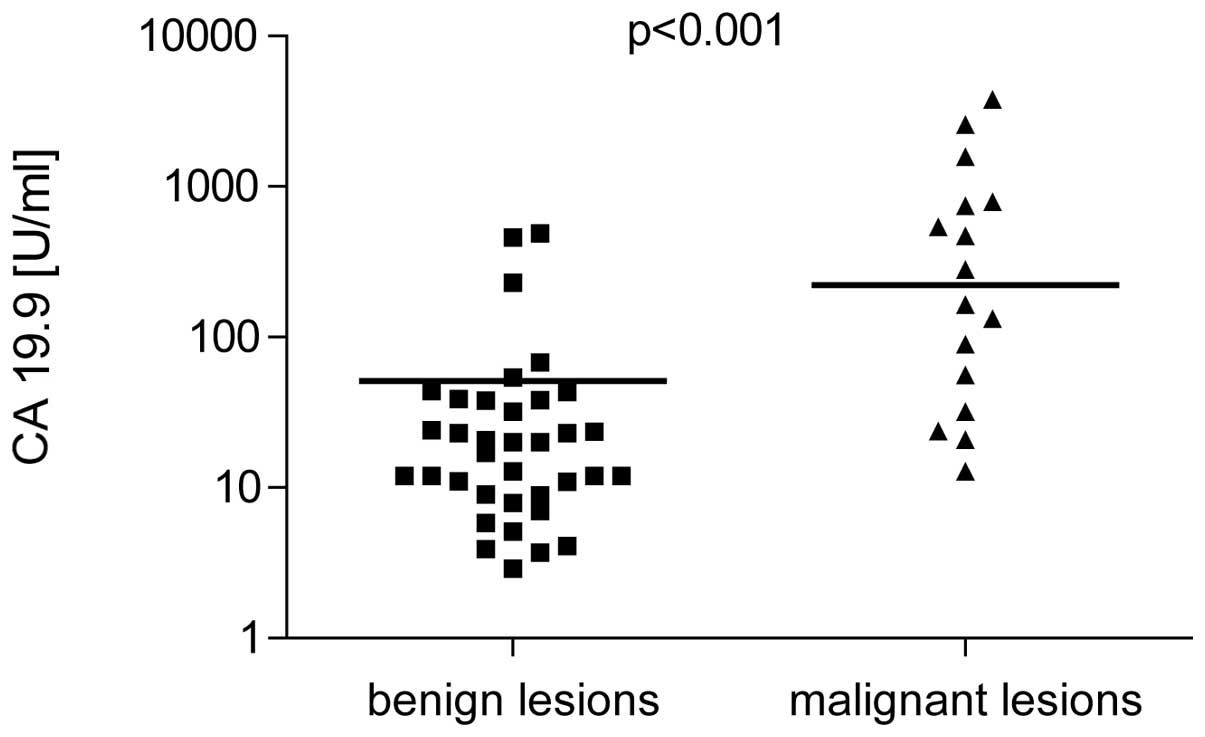|
1.
|
Testini M, Gurrado A, Lissidini G, Venezia
P, Greco L and Piccinni G: Management of mucinous cystic neoplasms
of the pancreas. World J Gastroenterol. 16:5682–5692. 2010.
View Article : Google Scholar : PubMed/NCBI
|
|
2.
|
Baiocchi GL, Portoliani N, Missale G, et
al: Intraductal papillary mucinous neoplasm of the pancreas (IPMN):
clinico-pathological correlations and surgical indications. World J
Surg Oncol. 7:8–25. 2010.PubMed/NCBI
|
|
3.
|
Leung KK, Ross WA, Evans D, Fleming J, Lin
E, Tamm EP and Lee JH: Pancreatic cystic neoplasm: the role of cyst
morphology, cyst fluid analysis and expectant management. Ann Surg
Oncol. 16:2818–2824. 2009. View Article : Google Scholar : PubMed/NCBI
|
|
4.
|
Michaels PJ, Brachtel EF, Bounds BC,
Brugge WR and Pitman MB: Intraductal papillary mucinous neoplasm
(IPMN) of the pancreas: cytopathologic analysis and correlation
with histologic grade. Cancer (Cancer Cytopathol). 108:163–173.
2006.
|
|
5.
|
Bhutani MS, Gupta V, Guha V, Gheonea DI
and Saftoiu A: Pancreatic cyst fluid analysis - a review. J
Gastrointestin Liver Dis. 20:175–180. 2011.PubMed/NCBI
|
|
6.
|
Park WG, Mascarenhas R, Palaez-Luna M, et
al: Diagnostic performance of cyst fluid carcinoembryonic antigen
and amylase in histologically confirmed pancreatic cysts. Pancreas.
40:42–45. 2011. View Article : Google Scholar : PubMed/NCBI
|
|
7.
|
Sawhney MS, Devarajan S, O’Farrel P, et
al: Comparison of carcinoembryonic antigen and molecular analysis
in pancreatic cyst fluid. Gastrointest Endoscopy. 69:1106–1110.
2009. View Article : Google Scholar : PubMed/NCBI
|
|
8.
|
Attasaranya S, Pais S, LeBlanc J, McHenry
L, Sherman S and DeWitt J: Endoscopic ultrasound-guided fine needle
aspiration and cyst fluid analysis for pancreatic cancer. J
Pancreas. 8:553–563. 2007.PubMed/NCBI
|
|
9.
|
Wu H, Cheng NS, Zhang YG, Luo HZ, Yan LN
and Li J: Improved early diagnosis of cystadenocarcinoma of the
pancreas. Hepatobiliary Pancreat Dis Int. 6:87–91. 2007.PubMed/NCBI
|
|
10.
|
Aljebreen AM, Romagnuolo J, Perini R and
Sutherland F: Utility of endoscopic ultrasound, cytology and fluid
carcinoembryonic antigen and CA 19-9 levels in pancreatic cystic
lesions. World J Gastroenterol. 13:3962–3966. 2007. View Article : Google Scholar : PubMed/NCBI
|
|
11.
|
Wu H, Yan LN, Cheng NS, Zhang YG and Ker
CG: Role of cystic fluid in diagnosis of the pancreatic cystadenoma
and cystadeno-carcinoma. Hepatogastroenterology. 54:1915–1918.
2007.PubMed/NCBI
|
|
12.
|
Snozek CL, Mascarenhas RC and O’Kane DJ:
Use of cyst fluid CEA, Ca19-9 and amylase for evaluation of
pancreatic lesions. Clin Biochem. 42:1585–1588. 2009. View Article : Google Scholar : PubMed/NCBI
|
|
13.
|
Obeso G, Murphy E, Brugge W and Deshpande
V: Pseudocyst of the pancreas: the role of cytology and special
stains for mucin. Cancer Cytopathol. 117:101–107. 2009. View Article : Google Scholar : PubMed/NCBI
|
|
14.
|
Talar-Wojnarowska R, Pazurek M, Durko Ł,
et al: A comparative analysis of K-ras mutation and
carcinoembryonic antigen in pancreatic cyst fluid. Pancreatology.
(In press).
|
|
15.
|
Frossard JL, Amouyal P, Amouyal G, et al:
Performance of endosonography-guided fine needle aspiration and
biopsy in the diagnosis of pancreatic cystic lesions. Am J
Gastroenterol. 98:1516–1524. 2003. View Article : Google Scholar : PubMed/NCBI
|
|
16.
|
Brugge WR, Lewandrowski K,
Lee-Lewandrowski E, et al: Diagnosis of pancreatic cystic
neoplasms: a report of the cooperative pancreatic cyst study.
Gastroenterology. 126:1330–1336. 2004. View Article : Google Scholar : PubMed/NCBI
|
|
17.
|
Van der Waaij LA, van Dullemen HM and
Porte RJ: Cyst fluid analysis in the differential diagnosis of
pancreatic cystic lesions: a pooled analysis. Gastrointest Endosc.
62:383–389. 2005.PubMed/NCBI
|
|
18.
|
Maire F, Voitot H, Aubert A, et al:
Intraductal papillary mucinous neoplasms of the pancreas:
performance of pancreatic fluid analysis for positive diagnosis and
the prediction of malignancy. Am J Gastroenterol. 103:2871–2877.
2008. View Article : Google Scholar : PubMed/NCBI
|
|
19.
|
Le Borgne J, de Calan L and Partensky C:
Cystadenomas and cystadenocarcinomas of the pancreas: a
multiinstitutional retrospective study of 398 cases. French
Surgical Association. Ann Surg. 230:152–161. 1999.PubMed/NCBI
|















